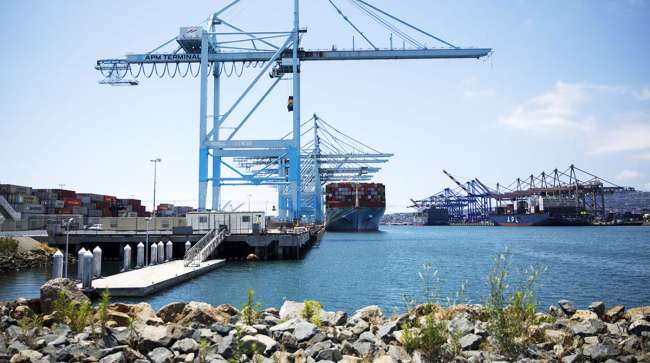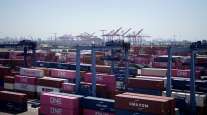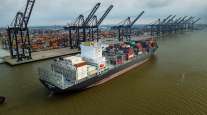Press-Telegram, Long Beach, Calif.
Port of L.A. Breaks Another Monthly Cargo Record

[Stay on top of transportation news: Get TTNews in your inbox.]
The Port of Los Angeles had its best-ever July, officials announced Aug. 17, outpacing the same month last year, which was the previous record, by 5%.
Dockworkers and terminal operators moved 935,345 20-foot equivalent units, the industry’s measuring standard, in July, good enough for yet another record-breaking month — a regular occurrence since the second half of 2022. The port has set new record highs in five out of the seven months this year so far.
And, according to Executive Director Gene Seroka, the nation’s busiest port is on pace to meet its all-time cargo record, set in 2021, even amid issues with consumer spending and supply chain backups. Despite those challengers, Seroka said during an Aug. 17 briefing, the port is freeing up space in the harbor and making swift progress toward streamlining the Southern California supply chain.
ICYMI -- Port of Los Angeles Breaks Another Cargo Record in July: The #PortofLA processed an estimated 935,345 TEUs in July 2022, outpacing the previous record set in 2019 by 2.5%. #AmericasPort has set monthly records in five of seven months in 2022. https://t.co/yd9U2TEv1k pic.twitter.com/MjuYbfE3Pq — Port of Los Angeles (@PortofLA) August 18, 2022
Though that data may change slightly once the numbers are finalized, port officials said they don’t expect any major differences from what they reported during the news briefing, which came about a week after the neighboring Port of Long Beach announced it had barely set its own July cargo record.
“Remarkably, we continue to move record amounts of cargo while working down the backlog of ships almost 90%,” Seroka said, “a huge accomplishment by all of our partners.”
The port imported just more than 485,000 loaded units last month, a 3.4% increase compared to July 2021 — and 8% higher than the previous five-year July average.
The port’s exports also did well in July, Seroka said, with a 13.5% increase in units moved compared to the same month last year.

Seroka
“While that’s a big number, exports have been down now for more than three years,” Seroka said. “We continue to work with the Commerce Department and others to finally turn this market around.”
There are a few key factors driving the port’s success this year, Seroka said: demand, fluidity and data.
“Retail, wholesale and manufacturing numbers have remained strong — we’ve seen peak season months for the past 2½,” Seroka said. “That said, imports will begin to ease somewhat; I expect to see that reflected in our August cargo numbers.”
China factory orders are reported to be slowing and some U.S. retailers have noted they continue to have “elevated” inventories, Seroka said. But even still, July retail sales reported this week are flat, which, Seroka said, is good news.
“It appears that consumers are using the money saved from falling gas prices to spend money on other goods,” he said.
And cargo is leaving the port’s marine terminals at a much faster place than last year.
A record 109 ships awaited entry into the combined ports of Los Angeles and Long Beach in January. That number, as of Aug. 15, had dropped to 13 ships at anchor in the harbor — an 88% decrease from just seven months ago.
On Aug. 11, that number stood at nine ships.
“That’s a huge accomplishment,” Seroka said, “all while moving record (cargo) volume.”
Trucks — which move about two-thirds of the port’s entire cargo, Seroka said — are also moving units at a faster pace. And containers are spending less time dwelling, or waiting, for an available truck to transport it to its final destination.
“We’re down to about 2,000 containers waiting 9-plus days for trucks, versus more than 32,000 units last October,” Seroka said. “Dwell time for truck-bound containers is now at four days, close to more traditional times and a significant improvement from the high of 11-days dwell.”
(Rail-bound cargo, however, has been a problem recently.)
That success, Seroka said, is due in part to the Port Optimizer data portal — a software system that allows port stakeholders to process supply chain data and identify potential cargo hold-ups before they become major issues.
The Port Optimizer, that crucial component of supply chain management, is set for some upgrades — thanks to a $3 million grant from the federal Department of Transportation.
That money “will be used to roll out new components of the Port Optimizer,” Seroka said, “further enhancing the data and analytics that stakeholders are increasingly dependent on every day.”
In recent months, the Southern California supply chain has improved significantly, Seroka said.
“At many other ports around the country, ships are waiting for space. Yet here, our terminals have capacity,” he said. “So for cargo owners looking to rechart their course, come to Los Angeles. We’re ready to help.”
The port will also receive another $20 million Department of Transportation grant for a grade separation project to improve truck access at the port’s Terminal Island.
Want more news? Listen to today's daily briefing above or go here for more info
“It will also reduce cargo congestion,” Seroka said, “while increasing safety for motorists.”
But the port’s grant funds won’t stop there — at least, that’s what officials are hoping.
President Joe Biden, on Aug. 16, signed the Inflation Reduction Act into law, which includes a $3 billion fund to help the nation’s ports transition to electricity-powered equipment and reduce their greenhouse gas emissions.
“As the Western Hemisphere’s busiest trade gateway, we’re pursuing every grant dollar available to accelerate plans to build resiliency, increase efficiencies and reduce our environmental footprint,” Seroka said, “all while creating more jobs here at America’s port.”
Distributed by Tribune Content Agency, LLC




